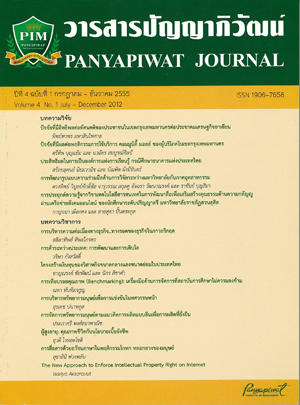การบริิหารทรัพยากรมนุษย์เพื่อการแข่งขันในทศวรรษหน้า
Main Article Content
บทคัดย่อ
ปัจจุบันองค์กรถูกท้าทายด้วยระบบโลกาภิวัฒน์ (Globalization) อันนำมาซึ่งการสร้างความได้เปรียบเชิงการแข่งขัน (Competitive Advantage) จึงส่งผลทำให้ผู้บริหารและฝ่ายทรัพยากรมนุษย์จำเป็นต้องปรับเปลี่ยนแนวทางการบริหารใหม่ภายใต้การบริหารงานเชิงกลยุทธ์ โดยเฉพาะอย่างยิ่งกลยุทธ์ด้านบุคลากรในองค์กรเพื่อรองรับสถานการณ์ต่างๆ ที่อาจจะเกิดขึ้นทั้งในปัจจุบันและอนาคต
"คนหรือทรัพยากรมนุษย์ (Human Resource)" ซึ่งมี "ปัญญาความรู้" และ "ทักษะความสามารถ" จึงถูก ชูขึ้นเป็นหัวใจหลักของการสร้างประสิทธิภาพของการทำงาน และขับเคลื่อนองค์กรให้รุกเติบโตอย่างมั่นคง เป็นเหตุให้องค์กรต้องเริ่มหันมาตระหนักถึงความสำคัญในเรื่องของการบริหารจัดการ "คน" เพราะการสร้างหรือพัฒนา "คน" ขององค์กรเปรียบเสมือนการพัฒนา "ทุน" ที่เป็นส่วนสำคัญขององค์กรที่เรียกกันว่า "ทุนมนุษย์ (Human Capital)" ซึ่งจะสามารถสร้างคุณค่า (Value Creation) อันมหาศาลและสร้างความได้เปรียบในเชิงการแข่งขัน (Competitive Advantage) ให้กับองค์กรนั้นๆ ได้ โดยต้องเปลี่ยนจาก "การบริหารคนเชิงรับ" มาเป็น "การบริหารคนเชิงรุก" คือ (1) เปลี่ยนจาก "การหาคนเก่งและคนดี" ไปเป็น "หาคนที่มีคุณค่า" (2) เปลี่ยนจากการ "รักษาคนดีให้อยู่กับองค์กรนานๆ" ไปเป็น "การบริหารคนที่มีคุณค่า" (3) เปลี่ยนจากสังคมของ "หัวหน้าลูกน้อง" ไปเป็น "สังคมเพื่อนร่วมงาน" (4) เปลี่ยนการทำงาน "ตามหน้าที่" ไปเป็น "ความรับผิดชอบต่อเป้าหมาย" (5) เปลี่ยนจากการ "ฝึกอบรมเพื่อแก้ไขอดีตและปรับปรุงปัจจุบัน" ไปเป็น "การสร้างคุณค่าคนเพื่อรองรับอนาคต" และ (6) เปลี่ยนจากวัฒนธรรม "ผู้ใหญ่ปกครองเด็ก" ไปเป็น "เด็กบริหารเด็ก"
บทบาทของการบริหารทรัพยากรมนุษย์จึงต้องเปลี่ยนแปลงไปตามบริบทของธุรกิจ (New Business Context) โดยมุ่งเน้นการสร้างสมดุลระหว่างทรัพยากรมนุษย์และธุรกิจขององค์กรโดยใช้วิธีการจัดการสมัยใหม่ (Modern Management) เพื่อให้เกิดผลสัมฤทธิ์สูงสุดขององค์กร
Organizations today are challenged by globalization which lead to the creation of competitive advantage. As a result, management and human resource management practices need to adapt new management strategies, especially human resources strategies in order to support existing organizational situations at the present and future time.
"Man or Human Resource" which has "intelligence" and "skills" are being held as the core performance of the work and to drive organizations to grow steadily. Organizations have started to recognize the importance of the management of "people" because the creation or development of "people" seems to be the development of a "capital" which is an important part of an organization known as the "Human Capital", which can create value and a tremendous competitive advantage to the organization that are subject to change from "The passive management" to "the proactive management" as (1) shift from "finding intelligent and good person" to "finding a valuable person"
(2) from "retaining lifelong employment of good person" to "valuable person management" (3) change of "boss & staff society" to "colleague society" (4) for working as "duty" to be "objective responsibility" (5) from training for "an improvement the past and the present," to "create value for the future," and (6) change of culture from "manage by superior" to "manage by themselves".
The role of human resource management is to change for the new business context, focusing on the balance between business and human resources of the organization through modern management for the achievement of the organization.
Article Details
“ข้าพเจ้าและผู้เขียนร่วม (ถ้ามี) ขอรับรองว่า บทความที่เสนอมานี้ยังไม่เคยได้รับการตีพิมพ์และไม่ได้อยู่ระหว่างกระบวนการพิจารณาลงตีพิมพ์ในวารสารหรือแหล่งเผยแพร่อื่นใด ข้าพเจ้าและผู้เขียนร่วมยอมรับหลักเกณฑ์การพิจารณาต้นฉบับ ทั้งยินยอมให้กองบรรณาธิการมีสิทธิ์พิจารณาและตรวจแก้ต้นฉบับได้ตามที่เห็นสมควร พร้อมนี้ขอมอบลิขสิทธิ์บทความที่ได้รับการตีพิมพ์ให้แก่สถาบันการจัดการปัญญาภิวัฒน์หากมีการฟ้องร้องเรื่องการละเมิดลิขสิทธิ์เกี่ยวกับภาพ กราฟ ข้อความส่วนใดส่วนหนึ่งและ/หรือข้อคิดเห็นที่ปรากฏในบทความข้าพเจ้าและผู้เขียนร่วมยินยอมรับผิดชอบแต่เพียงฝ่ายเดียว”
References
เกริกเกียรติ ศรีเสริมโชค. (2546). การพัฒนาความสามารถเชิงสมรรถนะ, กรุงเทพฯ: นาโกต้า.
จิรประภา อัครบวร. (2554). พัฒนาคนบนความยั่งยืนกรุงเทพฯ: เต่า (2000).
เจษฎา นกน้อย. (2552). แนวคิดการบริหารทรัพยากรมนุษย์ร่วมสมัย, กรุงเทพฯ: วี.พริ้นท์ (1991).
ดนัย เทียนพุฒ. (2545). การบริหารทรัพยากรมนุษย์ในทศวรรษหน้า, กรุงเทพฯ: จุฬาลงกรณ์มหาวิทยาลัย.
ดนัย เทียนพุฒ. (2555). การบรรยายเรื่อง “4 แนวโน้มใหม่ใน HR 2012”, 29 มีนาคม 2555 ณ โรงแรมแกรนด์ เมอร์เคียว ฟอร์จูน.
ธงชัย สมบูรณ์. (2549). การบริหารและจัดการมนุษย์ในองค์กร. กรุงเทพฯ: ปราชญ์สยาม.ในองค์กร. กรุงเทพฯ: ปราชญ์สยาม.
ธานินทร์ สุวงศ์วาร. (2547, พฤษภาคม 25). “บทบาทใหม่ HR สู่หุ้นส่วนกลยุทธ์ ความท้าทายที่รอการวัดฝีมือ”. ASTV ผู้จัดการ Magazine Online.
เนตร์พัณณา ยาวิราช. (2550), การจัดการสมัยใหม่ พิมพ์ครั้งที่ 6. กรุงเทพฯ: ทริปเปิ้ล กรุ๊ป.
ประเวศน์ มหารัตน์กุล. (2544). การบริหารทรัพยากรมนุษย์แนวทางใหม่. กรุงเทพฯ: สมาคมส่งเสริมเทคโนโลยี.
สมโภชน์ นพคุณ. (2552). การบริหารทรัพยากรบุคคลภาครัฐเชิงกลยุทธ์ (เอกสารบรรยาย), กรุงเทพฯ: สํานักงาน ก.พ.
สมาคมการจัดการงานบุคคลแห่งประเทศไทย (PMAT).(2552). การสำรวจแนวโน้มและความท้าทายในงานทรัพยากรมนุษย์:Past, Present and the Future. กรุงเทพ ฯ: สมาคม ฯ.
Armstrong, M. (2006). Strategic Human Resource Management: A Guide to Action 3 ed. UK: Kogan Page.
Ceriello, V.R. & Freeman, C. (1991). Human Resource Management System: Tactics and Techniques. New York: Lexington Books.
Certo, Samuel C. (2000). Modern Management:Diversity, Quality Ethics, and the Global Environment. London: Prentice Hall.
Dive, B. (2004). The healthy Organization: A Revolutionary Approach to People & Management. 21nd ed. UK: Kogan Page.
Lengnick-Hall, M.L. & Lengnick-Hall, C.A. (2003).Human Resource Management in the Knowledge Economy. San Francisco: Berrett Koehler Publishers.
Olve, Nils Goran, Roy, Jan & Wetter, Magnus.(1999). Performance Drivers: A Practical Guide to Using Balanced Scorecard. New Jersey: Wiley.

